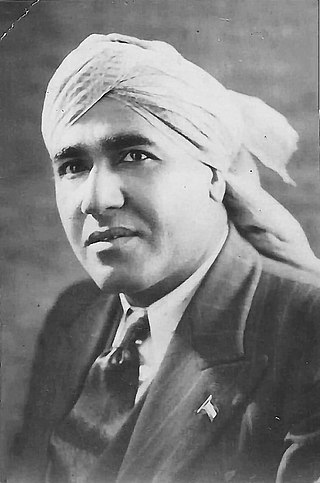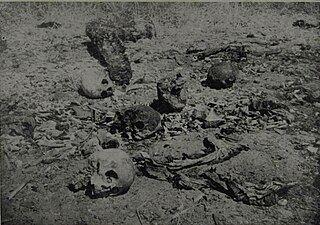The following outline is provides an overview of Sikhism, or Sikhi.

The Nishan Sahib, also known as the Sikh flag, is used to represent the Sikh people worldwide. In 1936, the Shiromani Gurdwara Parbandhak Committee ratified the Sikh Rehet Maryada, which states its colour as either basanti (xanthic) or surmai. It is a triangular flag with a Khanda in its centre, made of cotton or silk cloth, and has a tassel at its end.

Udham Singh was an Indian revolutionary belonging to Ghadar Party and HSRA, best known for assassinating Michael O'Dwyer, the former lieutenant governor of the Punjab in India, on 13 March 1940. The assassination was done in revenge for the Jallianwala Bagh massacre in Amritsar in 1919, for which O'Dwyer was responsible and of which Singh himself was a survivor. Singh was subsequently tried and convicted of murder and hanged in July 1940. While in custody, he used the name 'Ram Mohammad Singh Azad', which represents the three major religions in India and his anti-colonial sentiment.
The Akhand Kirtani Jatha, alternatively romanized as the Akhand Keertanee Jathaa and abbreviated as AKJ, is a jatha and sect of Sikhism dedicated to the Sikh lifestyle. The Jatha follows a strict discipline in keeping the Rehat of Guru Gobind Singh. They also enjoy an active style of Keertan recited by Sikhs in a collective manner in front of Guru Granth Sahib. This style of Keertan is relatively simple, and the entire congregation devotionally participates in singing along.

Panj Pyare refers to a gathered ad hoc quintet of five baptised (Amritdhari) Khalsa Sikhs who act as institutionalized leaders for the wider Sikh community.

Bhai Mani Singh was an 18th-century Sikh scholar and martyr. He was a childhood companion of Guru Gobind Singh and took the vows of Sikhism when the Guru inaugurated the Khalsa in March 1699. Soon after that, the Guru sent him to Amritsar to take charge of Harmandir Sahib, which had been without a custodian since 1696. He took control and steered the course of Sikh destiny at a critical stage in Sikh history. He was also a teacher of the Gianian Bunga, later becoming known as the "Amritsari Taksal", currently located in Sato Ki Gali.

Sikh music, also known as Gurbani Sangeet , and as Gurmat Sangeet, or even as Shabad Kirtan, is the classical music style that is practised within Sikhism. It exists in institutional, popular, and folk traditions, forms, and varieties. Three types of Sikh musicians are rababis, ragis, and dhadhis. Sikh music exists in various melodic modes, musical forms, styles, musicians, and performance contexts.

Majha is a region located in the central parts of the historical Punjab region, currently split between the republics of Pakistan and India. It extends north from the right banks of the river Beas, and reaches as far north as left bank of the river Ravi, constituting upper half of the Bari Doab.
Rehat refers to the rules and traditions which govern the unique Sikh lifestyle and determines correct Sikh orthodoxy and orthopraxy. The Sikh Rehit Maryada is a code of conduct and conventions for Sikhism. The final version of the Rehat Maryada was controversially approved by the Shiromani Gurdwara Parbandhak Committee, Amritsar in 1945. The Rehat Maryada was created to provide guidance to Sikhs on practical and functional aspects of daily life, including the operations of Sikh Gurdwaras, and religious practices to foster cohesion throughout the community. Rehitnāma is a Punjabi term that refers to a genre of Sikh religious literature which expounds upon specifying an approved way of life for a Sikh.

Glen Cove's Gurdwara Mata Sahib Kaur is a Sikh Gurdwara or temple in Glen Cove on Long Island, New York. It has an area of 15 acres near Long Island Sound. Gurdwara Sahib attracts an average weekly congregation of 200 families from the surrounding area. As of 2017, the head granthi was Paramjit Singh.

The Chief Khalsa Diwan or Chief Khalsa Diwan Charitable Society is a Sikh organisation that is the central organization of various Singh Sabhas spread across Punjab, India. Unlike the Shiromani Gurudwara Prabandhak Committee, the C.K.D. is an apolitical body and only concerns itself with religious, educational and cultural issues. The organization originally controlled Sikh religious and educational concerns and was an advocate of Sikh political rights, though it presently is mostly limited to educational spheres. It was the main council of Sikhs until the birth of more radical organizations, such as the Central Sikh League, the S.G.P.C., and the Akali Dal.

Amrik Singh was the President of the All India Sikh Students Federation. He was killed in the Indian Army's operation on the Golden Temple on June 6, 1984.

Anita Anand is a British radio and television presenter, journalist, historian, and author.
Jathedar Bhai Tehal Singh Dhanju was a Sikh religious figure. He played an important role in awakening the Sikh masses during the Gurdwara Reform Movement in the early 20th century. He work for the liberation of Sikh Gurdwaras from the corrupt Mahants. He is among the list of Sikh martyrs who struggled and volunteered for the liberation of Gurdwara Nankana Sahib from Mahant Narain Das on 20 February 1921. Every year on 21 February at the Shaheedi Asthan, Guru Granth Sahib's Swaroop with bullet marks is brought to Deewan from 2pm to 4pm for darshan of the Sikh Sangat.

Chhota Ghallughara was a massacre of a significant proportion of the Sikh population by the Mughal Empire in 1746. The Mughal Army killed an estimated 7,000 Sikhs in these attacks while an additional 3,000 Sikhs were taken captive. Chhōtā Ghallūghārā is distinguished from the Vaddā Ghallūghārā, the greater massacre of 1762.

Bhai Nirmal Singh Khalsa was a Sikh Hazoori Ragi of Darbar Sahib in Amritsar, Punjab, India.

The Jathedar of the Akal Takht is the head of the Akal Takht and head of the Sikhs worldwide. The jathedar has the de facto power as the supreme spokesperson of the Khalsa to summon, trial and sentence any person who identifies as a Sikh from the Akal Takht.

The Patient Assassin, A True Tale of Massacre, Revenge and the Raj is a 2019 book based on the life of Indian revolutionary Udham Singh. Authored by Anita Anand, it was published by Simon & Schuster UK in April 2019 to coincide with the 100th anniversary of the Jallianwalla Bagh Massacre in Amritsar, India.

Balbir Singh was a Sikh Hazuri Ragi who sang and performed at the Golden Temple in Amritsar for 36 years. He was one of the last masters of traditional Sikh gurbani kirtan of the Golden Temple.














